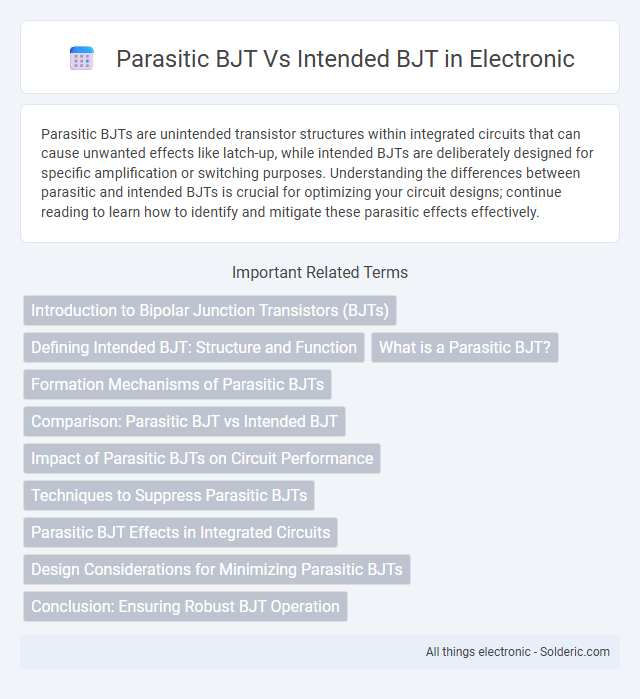Parasitic BJTs are unintended transistor structures within integrated circuits that can cause unwanted effects like latch-up, while intended BJTs are deliberately designed for specific amplification or switching purposes. Understanding the differences between parasitic and intended BJTs is crucial for optimizing your circuit designs; continue reading to learn how to identify and mitigate these parasitic effects effectively.
Comparison Table
| Feature | Parasitic BJT | Intended BJT |
|---|---|---|
| Definition | Unintended bipolar junction transistor formed within ICs | Designed bipolar junction transistor for controlled operation |
| Function | Causes leakage, latch-up, and instability in circuits | Amplification and switching in analog and digital circuits |
| Occurrence | Occurs unintentionally due to device geometry and doping | Fabricated intentionally with precise doping and layout |
| Control | Typically undesired; minimized by design techniques | Precisely controlled parameters for reliable operation |
| Impact | Degrades performance via latch-up, noise, or failure | Enhances circuit performance and functionality |
| Location | Embedded inside CMOS wells or junctions unintentionally | Placed deliberately in transistor regions |
Introduction to Bipolar Junction Transistors (BJTs)
Bipolar Junction Transistors (BJTs) are semiconductor devices consisting of three layers: emitter, base, and collector, designed to amplify current. Intended BJTs are deliberately fabricated to control electron flow efficiently for switching and amplification in electronic circuits. Parasitic BJTs, however, are unintended transistor structures formed within semiconductor devices that can cause undesirable effects like latch-up, impacting circuit reliability.
Defining Intended BJT: Structure and Function
Intended BJTs are deliberately designed bipolar junction transistors with a well-defined layer structure comprising the emitter, base, and collector, enabling precise control of current amplification and switching functions. Their semiconductor layers are engineered to optimize charge carrier injection and recombination, directly influencing parameters like gain (b), switching speed, and breakdown voltage. Understanding the intended BJT's structure helps you differentiate it from parasitic BJTs, which form unintentionally within integrated circuits and can degrade device performance.
What is a Parasitic BJT?
A Parasitic BJT is an unintended bipolar junction transistor formed within an integrated circuit structure, resulting from the inherent arrangement of semiconductor layers in devices like MOSFETs. This parasitic device can cause latch-up issues by creating low-resistance paths between power rails, leading to circuit malfunction or damage. Understanding and controlling Parasitic BJTs is crucial for improving the reliability and performance of CMOS technology.
Formation Mechanisms of Parasitic BJTs
Parasitic BJTs form unintentionally within semiconductor devices due to the inherent layering and doping profiles of CMOS transistors, typically arising from the interaction between source, drain, and substrate regions. These unintended transistor structures emerge when the p-n junctions create a bipolar transistor effect, often involving the source or drain as the emitter, the substrate as the base, and the bulk or well region as the collector. Understanding the diffusion gradients, impurity concentrations, and device geometry is critical to identifying and mitigating parasitic BJT activation in integrated circuits.
Comparison: Parasitic BJT vs Intended BJT
Parasitic BJTs are unintended transistor structures formed within a semiconductor device, often causing latch-up and malfunction, whereas intended BJTs are deliberately designed for amplification and switching in circuits. Intended BJTs exhibit controlled gain, predictable behavior, and stable electrical characteristics, while parasitic BJTs exhibit unpredictable responses and can degrade device reliability. Minimizing parasitic BJTs involves optimizing device layout and doping profiles to suppress unwanted transistor action and ensure robust circuit performance.
Impact of Parasitic BJTs on Circuit Performance
Parasitic BJTs significantly degrade circuit performance by introducing unintended current paths that cause leakage, increased power consumption, and reduced switching speed. These parasitic transistors can lead to latch-up in CMOS circuits, resulting in circuit malfunction and reliability issues. Understanding the impact of parasitic BJTs is crucial for optimizing your circuit design to ensure stability and efficient operation.
Techniques to Suppress Parasitic BJTs
Techniques to suppress parasitic BJTs in semiconductor devices include implementing guard rings, using substrate contacts, and optimizing doping profiles to reduce unwanted current paths. Shallow trench isolation (STI) and insulating layers help isolate the parasitic transistor regions, minimizing latch-up risk and enhancing device stability. Your circuit's robustness and performance improve significantly by carefully applying these suppression strategies during IC design.
Parasitic BJT Effects in Integrated Circuits
Parasitic Bipolar Junction Transistors (BJTs) in integrated circuits can lead to unintended current paths, causing latch-up and device malfunction by triggering parasitic thyristor action within CMOS structures. These effects degrade circuit performance and reliability, as the parasitic BJTs amplify leakage currents and can induce thermal runaway under certain biasing conditions. Mitigating parasitic BJT effects involves careful layout design, guard rings, and substrate engineering to minimize their influence on intended BJT operation and overall IC stability.
Design Considerations for Minimizing Parasitic BJTs
Design considerations for minimizing parasitic BJTs include careful layout techniques such as increasing the spacing between device regions and using guard rings to isolate sensitive areas. Incorporating substrate contacts and optimizing doping profiles reduce unintended bipolar action by controlling current flow paths. You can also enhance device reliability by selecting materials and geometries that suppress parasitic transistor activation during high-voltage or high-frequency operation.
Conclusion: Ensuring Robust BJT Operation
Parasitic BJTs, which inherently form in semiconductor structures, can disrupt your circuit's intended operation by causing unintended feedback or latch-up, contrasting with the controlled behavior of intended BJTs designed for specific amplification or switching roles. Ensuring robust BJT operation involves careful layout design, proper doping profiles, and the implementation of guard rings or isolation techniques to mitigate parasitic effects. Thorough understanding and management of parasitic BJTs enhance device reliability and maintain the integrity of your electronic systems.
Parasitic BJT vs Intended BJT Infographic

 solderic.com
solderic.com